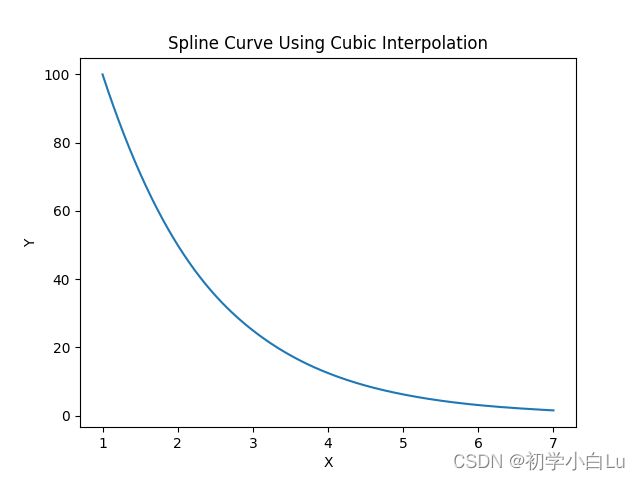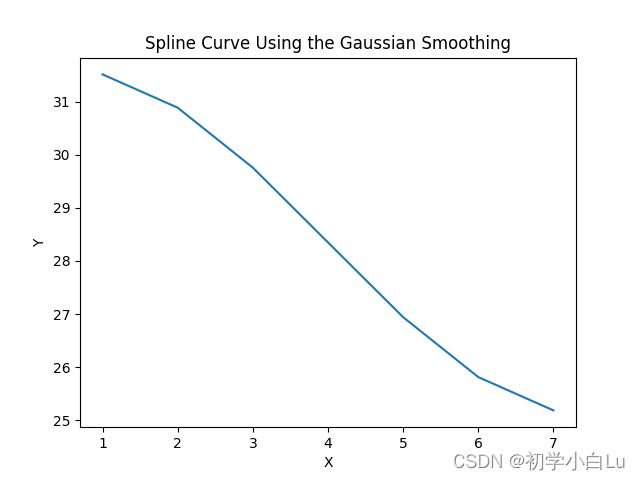Matplotlib绘制动图以及绘制平滑曲线
文章目录
- 绘制动图
-
- FuncAnimation
-
- 方法
- ArtistAnimation
-
- 方法
- 绘制平滑曲线
-
- 使用 scipy.ndimage.gaussian_filter1d() 高斯核类绘制平滑曲线
- 使用 scipy.interpolate.make_interp_spline() 样条插值类绘制平滑曲线
- 使用 scipy.interpolate.interp1d 插值类绘制平滑曲线
- 拟合曲线后绘制动图
绘制动图

FuncAnimation,它的使用要求简洁且定制化程度较高。如果想将很多图片合并为一个动图,那么ArtistAnimation是最合适的选择。
FuncAnimation
通过反复调用同一函数来制作动画。
注意:创建FuncAnimation对象后一定要将其赋值给某个变量,否则系统会将其进行垃圾回收。
class matplotlib.animation.FuncAnimation(fig,
func,
frames=None,
init_func=None,
fargs=None,
save_count=None, *,
cache_frame_data=True,
**kwargs)
参数:
- fig:Figure。用于显示动画的figure对象
- func:callable。用于更新每帧动画的函数。func函数的第一个参数为帧序号。返回被更新后的图形对象列表。
- frames:iterable, int, generator function, or None, optional。动画长度,帧序号组成的列表
- init_func:callable, optional。自定义开始帧,即绘制初始化图形的初始化函数
- fargs:tuple or None, optional。额外的需要传递给func函数的参数。
- save_count:int, default: 100。保存计数
- cache_frame_data:bool, default: True
- interval:int, default: 200。重复调用功能函数的间隔时间,单位是毫秒。
- repeat_delay:int, default: 0。当repeat为True时,动画延迟多少毫秒再循环。
- repeat:bool, default: True。是否是循环动画。
- blit:bool, default: False。选择更新所有点,还是仅更新产生变化的点。
示例:
import numpy as np
import matplotlib.pyplot as plt
from matplotlib.animation import FuncAnimation
fig = plt.figure()
ax = fig.subplots()
t=np.linspace(0,10,100)
y=np.sin(t)
ax.set_aspect(3)
ax.plot(t,y,'--',c='gray')
line=ax.plot(t,y,c='C2')
def update(i): #帧更新函数
global t #直接引用全局变量,也可以通过函数的frames或fargs参数传递。
t+=0.1
y=np.sin(t)
line[0].set_ydata(y)
return line
ani=FuncAnimation(fig,update,interval=100) #绘制动画
plt.show() #显示动画
import numpy as np
import matplotlib.pyplot as plt
import matplotlib.animation as animation
fig = plt.figure(figsize=(7, 2), dpi=100)
ax = plt.subplot()
X = np.linspace(-np.pi, np.pi, 256, endpoint=True)
C, S = np.cos(X), np.sin(X)
line1, = ax.plot(X, C, marker="o", markevery=[-1], markeredgecolor="white")
line2, = ax.plot(X, S, marker="o", markevery=[-1], markeredgecolor="white")
def update(frame):
line1.set_data(X[:frame], C[:frame])
line2.set_data(X[:frame], S[:frame])
ani = animation.FuncAnimation(fig, update, interval=10)
plt.show()
方法
- init(fig, func[, frames, init_func, …])
- new_frame_seq()
- new_saved_frame_seq()
- pause()
- resume()
- save(self, filename, writer=None, fps=None, dpi=None, codec=None, bitrate=None, extra_args=None, metadata=None, extra_anim=None, savefig_kwargs=None)
- filename:保存的文件名
- writer:FFMpegFileWriter,ImageMagickFileWriter, AVConvFileWriter对象实例,或者表示这些对象的字符串(‘ffmpeg’, ‘imagemagick’,‘avconv’)
- fps:每秒的帧数
- to_jshtml([fps, embed_frames, default_mode])
返回js动画,用base64文本编码。
- fps:每秒帧数,默认根据动画的interval确定。
- embed_frames:布尔类型,是否嵌入帧。
- default_mode:‘loop’,‘once’或者’reflect’
ArtistAnimation
通过调用一个固定的Artist对象来制作动画,例如给定的系列图片或者matplotlib的绘图对象.。
class matplotlib.animation.ArtistAnimation(fig, artists, *args, **kwargs)
参数:
- fig:Figure
- artists:list
- interval:int, default: 200。每一帧之间的间隔
- repeat_delay:int, default: 0。每显示一次动画后间隔多长时间重复
- repeat:bool, default: True。是否重复动画
- blit:bool, default: False
示例:
import numpy as np
import matplotlib.pyplot as plt
from matplotlib.animation import ArtistAnimation
fig = plt.figure()
ax = fig.subplots()
arts=[]
t=np.linspace(0,np.pi*2,20)
for i in range(20):
t+=np.pi*2/20
y=np.sin(t)
lines=ax.plot(y,'--',c='gray') #绘制一帧图形
arts.append(lines) #每帧图形都保存到列表中
ani=ArtistAnimation(fig,arts,interval=200) #绘制动画
#ani.save("animate_artists_basic.gif") #保存动画
plt.show() #显示动画
方法
__init__(fig, artists, *args, **kwargs)
new_frame_seq()
new_saved_frame_seq()
pause()
resume()
save(filename[, writer, fps, dpi, codec, ...])
参数:
- filename:保存的动画文件名称,如’mov.gif’,‘mov.mp4’。
- writer:保持动画的库。MoviewWriter对象或者字符串。默认值’ffmpeg’。
“pillow”:PillowWriter,用pillow库写如动画文件。
“ffmpeg”:FFMpegWriter,基于ffmpeg库写动画。
“ffmpeg_file”:FFMpegFileWriter,基于文件的FFMpegWriter,用ffmpeg库把帧写入临时文件,然后拼接成动画。
“imagemagick”:ImageMagickWriter,基于管道的动画GIF。帧通过管道传输到ImageMagick并写入文件。
“imagemagick_file”:基于文件的imagemagick写动画。
“hmtl”:HTMLWriter,基于javascript html的动画。 - fps:每秒帧数,默认根据动画的interval确定
- dpi:每英寸点数,默认和figure相同。可以控制动画大小尺寸。
- codec:编码格式,默认’h264’
to_html5_video([embed_limit])
- embed_limit:动画文件大小限制,单位为MB。默认为20MB,超出限制则不创建动画。
绘制平滑曲线
import numpy as np
import matplotlib.pyplot as plt
x = np.array([1, 2, 3, 4, 5, 6, 7])
y = np.array([100, 50, 25, 12.5, 6.25, 3.125, 1.5625])
plt.plot(x, y)
plt.title("Spline Curve")
plt.xlabel("X")
plt.ylabel("Y")
plt.show()
使用 scipy.ndimage.gaussian_filter1d() 高斯核类绘制平滑曲线
import numpy as np
import matplotlib.pyplot as plt
from scipy.ndimage import gaussian_filter1d
x=np.array([1,2,3,4,5,6,7])
y=np.array([100,50,25,12.5,6.25,3.125,1.5625])
y_smoothed = gaussian_filter1d(y, sigma=5)
plt.plot(x, y_smoothed)
plt.title("Spline Curve Using the Gaussian Smoothing")
plt.xlabel("X")
plt.ylabel("Y")
plt.show()
使用 scipy.interpolate.make_interp_spline() 样条插值类绘制平滑曲线
import numpy as np
from scipy.interpolate import make_interp_spline
import matplotlib.pyplot as plt
x=np.array([1,2,3,4,5,6,7])
y=np.array([100,50,25,12.5,6.25,3.125,1.5625])
model=make_interp_spline(x, y)
xs=np.linspace(1,7,500)
ys=model(xs)
plt.plot(xs, ys)
plt.title("Smooth Spline Curve")
plt.xlabel("X")
plt.ylabel("Y")
plt.show()

它通过使用 scipy.interpolate.make_interp_spline() 首先确定花键曲线的系数,绘制出一条平滑的花键曲线。我们用给定的数据来估计花样曲线的系数,然后用系数来确定间隔紧密的 x 值的 y 值,使曲线平滑。绘制曲线需要沿 X 轴 1 到 7 之间间隔相等的 500。
使用 scipy.interpolate.interp1d 插值类绘制平滑曲线
import numpy as np
from scipy.interpolate import interp1d
import matplotlib.pyplot as plt
x=np.array([1,2,3,4,5,6,7])
y=np.array([100,50,25,12.5,6.25,3.125,1.5625])
cubic_interploation_model=interp1d(x,y,kind="cubic")
xs=np.linspace(1,7,500)
ys=cubic_interploation_model(xs)
plt.plot(xs, ys)
plt.title("Spline Curve Using Cubic Interpolation")
plt.xlabel("X")
plt.ylabel("Y")
plt.show()

绘制曲线时,需要在 X 轴上 1 和 7 之间取间隔相等的 500 个点。
拟合曲线后绘制动图
import numpy as np
import matplotlib.pyplot as plt
import matplotlib.animation as animation
from scipy.interpolate import interp1d
fig = plt.figure(figsize=(7, 2), dpi=100)
ax = plt.subplot()
x = np.array([1, 2, 3, 4, 5, 6, 7])
y = np.array([100, 50, 25, 12.5, 6.25, 3.125, 1.5625])
cubic_interploation_model = interp1d(x, y, kind="cubic")
xs = np.linspace(1, 7, 500)
ys = cubic_interploation_model(xs)
line3 = ax.plot(xs, ys)
def update(frame):
line3[0].set_data(xs[:frame], ys[:frame])
ani = animation.FuncAnimation(fig, update, interval=10)
plt.show()




